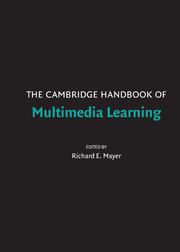Book contents
- Frontmatter
- Contents
- Preface
- Contributors
- 1 Introduction to Multimedia Learning
- PART I THEORETICAL FOUNDATIONS
- PART II BASIC PRINCIPLES OF MULTIMEDIA LEARNING
- 6 Five Common but Questionable Principles of Multimedia Learning
- 7 The Multimedia Principle
- 8 The Split-Attention Principle in Multimedia Learning
- 9 The Modality Principle in Multimedia Learning
- 10 The Redundancy Principle in Multimedia Learning
- 11 Principles for Managing Essential Processing in Multimedia Learning : Segmenting, Pretraining, and Modality Principles
- 12 Principles for Reducing Extraneous Processing in Multimedia Learning : Coherence, Signaling, Redundancy, Spatial Contiguity, and Temporal Contiguity Principles
- 13 Principles of Multimedia Learning Based on Social Cues : Personalization, Voice, and Image Principles
- PART III ADVANCED PRINCIPLES OF MULTIMEDIA LEARNING
- PART IV MULTIMEDIA LEARNING IN CONTENT AREAS
- PART V MULTIMEDIA LEARNING IN ADVANCED COMPUTER-BASED CONTEXTS
- Author Index
- Subject Index
- References
10 - The Redundancy Principle in Multimedia Learning
Published online by Cambridge University Press: 05 June 2012
- Frontmatter
- Contents
- Preface
- Contributors
- 1 Introduction to Multimedia Learning
- PART I THEORETICAL FOUNDATIONS
- PART II BASIC PRINCIPLES OF MULTIMEDIA LEARNING
- 6 Five Common but Questionable Principles of Multimedia Learning
- 7 The Multimedia Principle
- 8 The Split-Attention Principle in Multimedia Learning
- 9 The Modality Principle in Multimedia Learning
- 10 The Redundancy Principle in Multimedia Learning
- 11 Principles for Managing Essential Processing in Multimedia Learning : Segmenting, Pretraining, and Modality Principles
- 12 Principles for Reducing Extraneous Processing in Multimedia Learning : Coherence, Signaling, Redundancy, Spatial Contiguity, and Temporal Contiguity Principles
- 13 Principles of Multimedia Learning Based on Social Cues : Personalization, Voice, and Image Principles
- PART III ADVANCED PRINCIPLES OF MULTIMEDIA LEARNING
- PART IV MULTIMEDIA LEARNING IN CONTENT AREAS
- PART V MULTIMEDIA LEARNING IN ADVANCED COMPUTER-BASED CONTEXTS
- Author Index
- Subject Index
- References
Summary
Abstract
The redundancy principle suggests that redundant material interferes with rather than facilitates learning. Redundancy occurs when the same information is presented in multiple forms or is unnecessarily elaborated. In this chapter, the long, but until recently unknown, history of the principle is traced. In addition, an explanation of the principle using cognitive load theory is provided. The theory suggests that coordinating redundant information with essential information increases working memory load, which interferes with the transfer of information to long-term memory. Eliminating redundant information eliminates the requirement to coordinate multiple sources of information. Accordingly, instructional designs that eliminate redundant material can be superior to those that include redundancy.
Introduction
The history of the redundancy effect or principle is a history of academic amnesia. The effect has been discovered, forgotten, and rediscovered many times over many decades. This unusual history probably has two related causes: first, the effect is seen as counterintuitive by many researchers and practitioners and second, until recently, there has not been a clear theoretical explanation to place it into context. As a consequence of these two factors, demonstrations of the effect have tended to be treated as isolated peculiarities unconnected to any mainstream work. Memories of each demonstration have faded with the passage of time until the next demonstration has appeared. Worse, each demonstration has tended to be unconnected to the previous one. Hopefully, current explanations of the effect can alter this lamentable state of affairs.
- Type
- Chapter
- Information
- The Cambridge Handbook of Multimedia Learning , pp. 159 - 168Publisher: Cambridge University PressPrint publication year: 2005
References
- 87
- Cited by

